Geology: Notable Rocks, Minerals, Fossils, Craters, Germs, etc. (Official Set)
1/102
There's no tags or description
Looks like no tags are added yet.
Name | Mastery | Learn | Test | Matching | Spaced |
|---|
No study sessions yet.
103 Terms
Acasta Gneiss (Fact 1)
Igneous Rock, it is the oldest known (exposed) rock on Earth dating to around 4 BYA
Amphibole (Fact 1)
Family of Silicate minerals (((RSi4O11)2) (where R can be any number of cations)) in which its structure is that of a double polymer chain of Silicon-Oxygen Tetrahedra in which all three (corner) Oxygen atoms each bond to another (corner) Oxygen atom and in which each double chain is connected by a metal cation
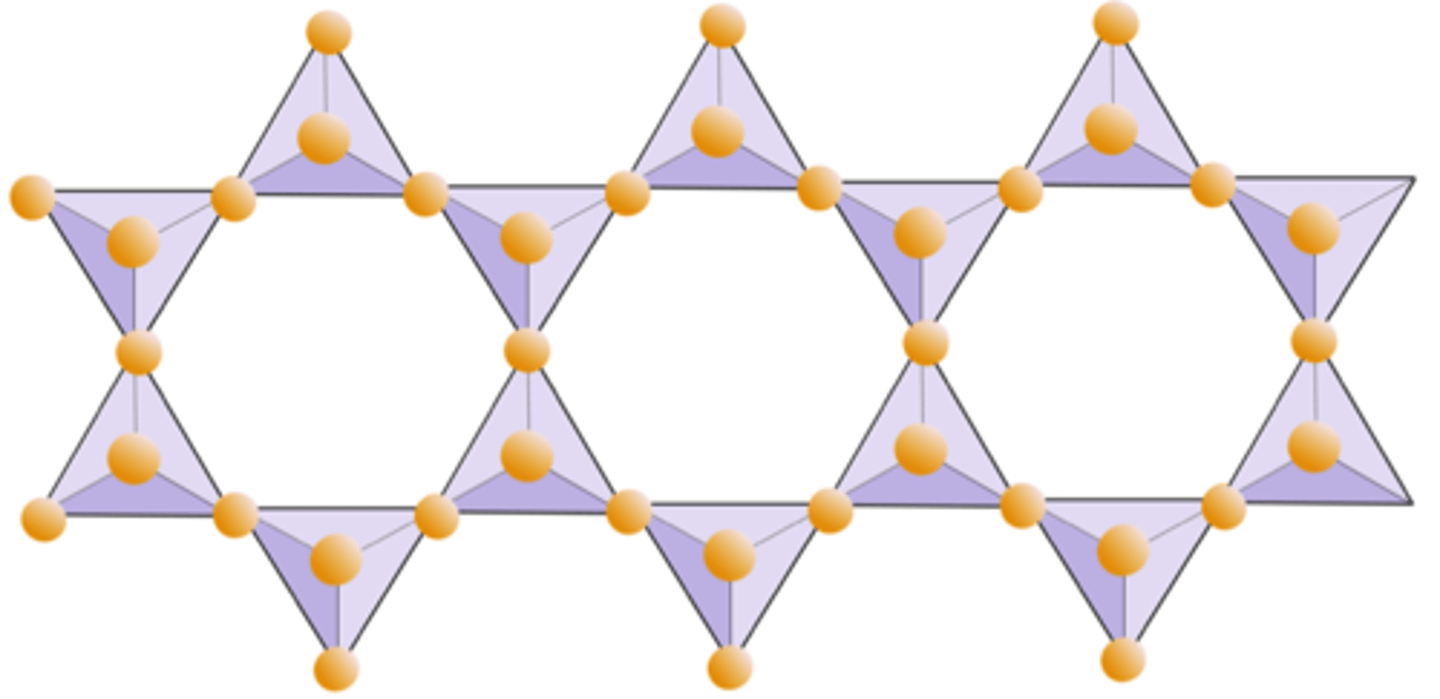
Amphibole (Fact 2)
Family of Silicate minerals (((RSi4O11)2) (where R can be any number of cations)) typically found in mafic igneous rocks and some metamorphic rocks such as Gabbro, Basalt, Diorite, and Granite
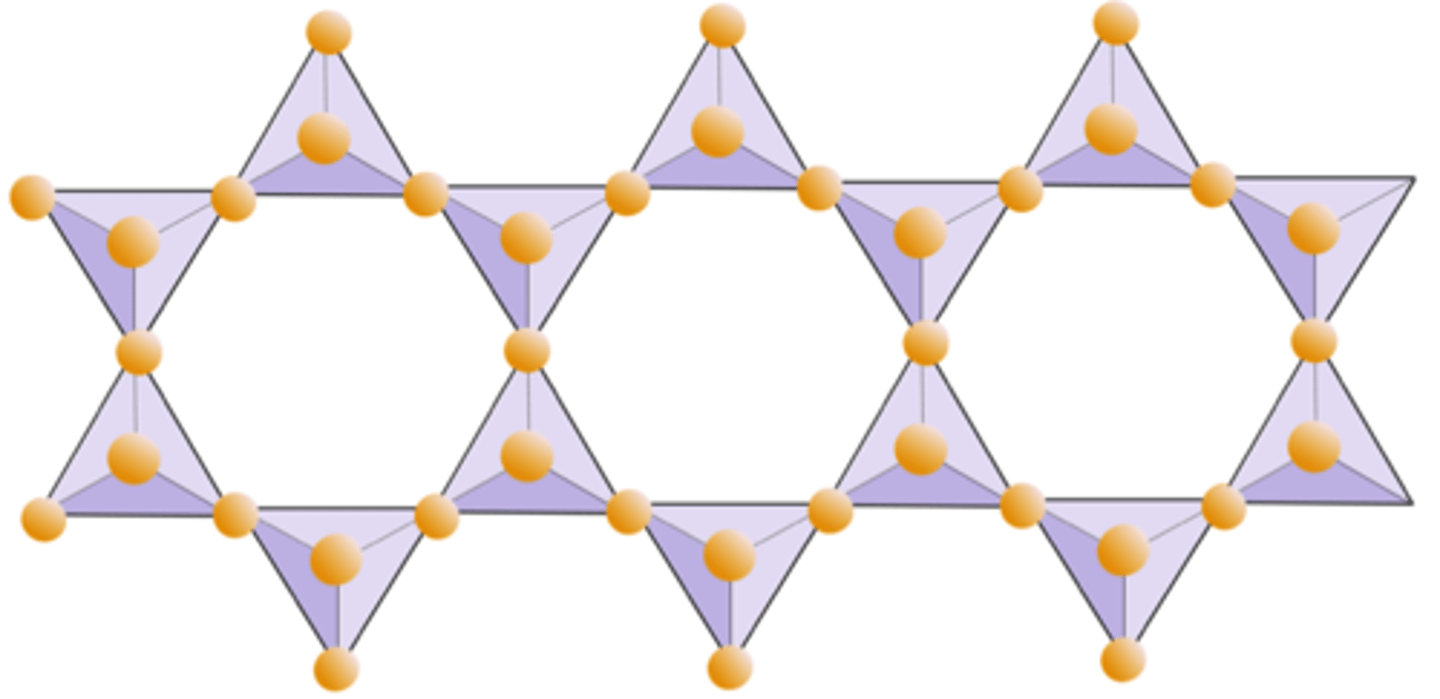
Amphibole (Fact 3)
Family of Silicate minerals (((RSi4O11)2) (where R can be any number of cations)) in which its structure is that of 2 Pyroxene chains put together
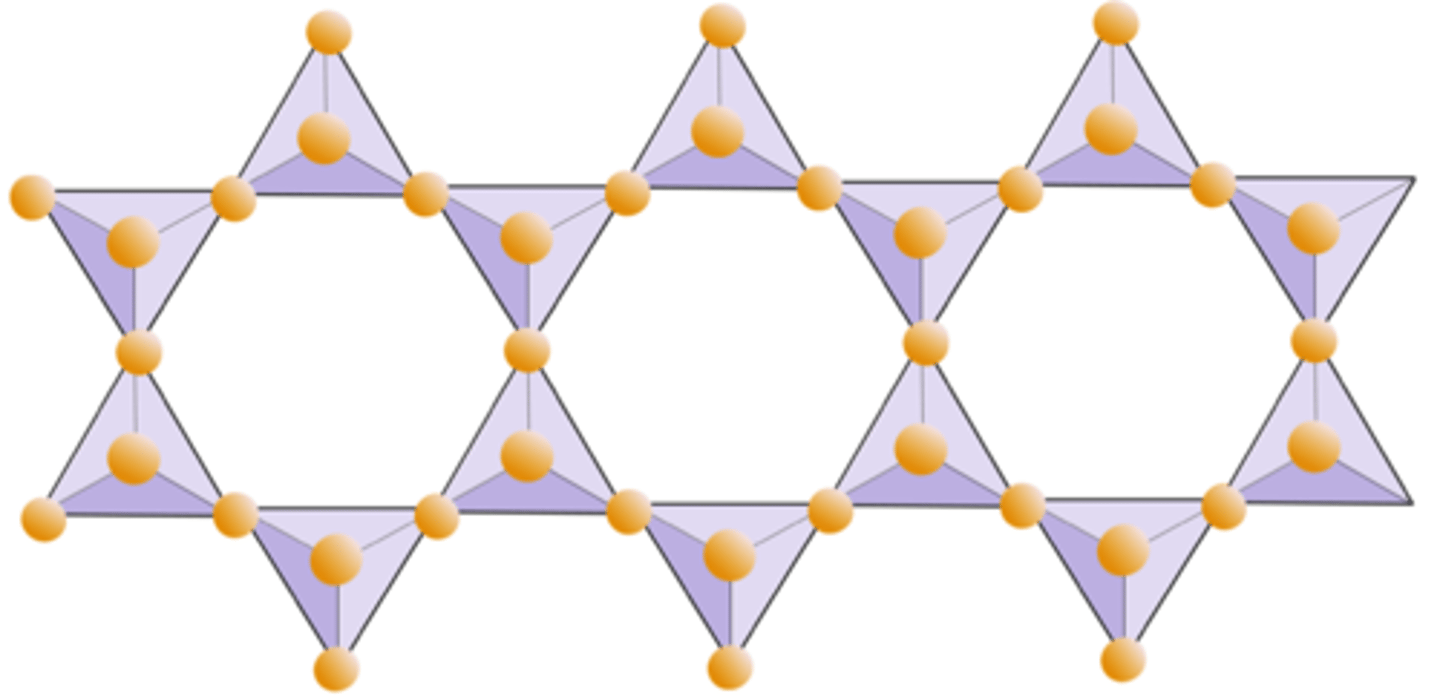
Amphibole (Fact 4)
Family of Silicate minerals (((RSi4O11)2) characterized by having a long-bladed crystal habit
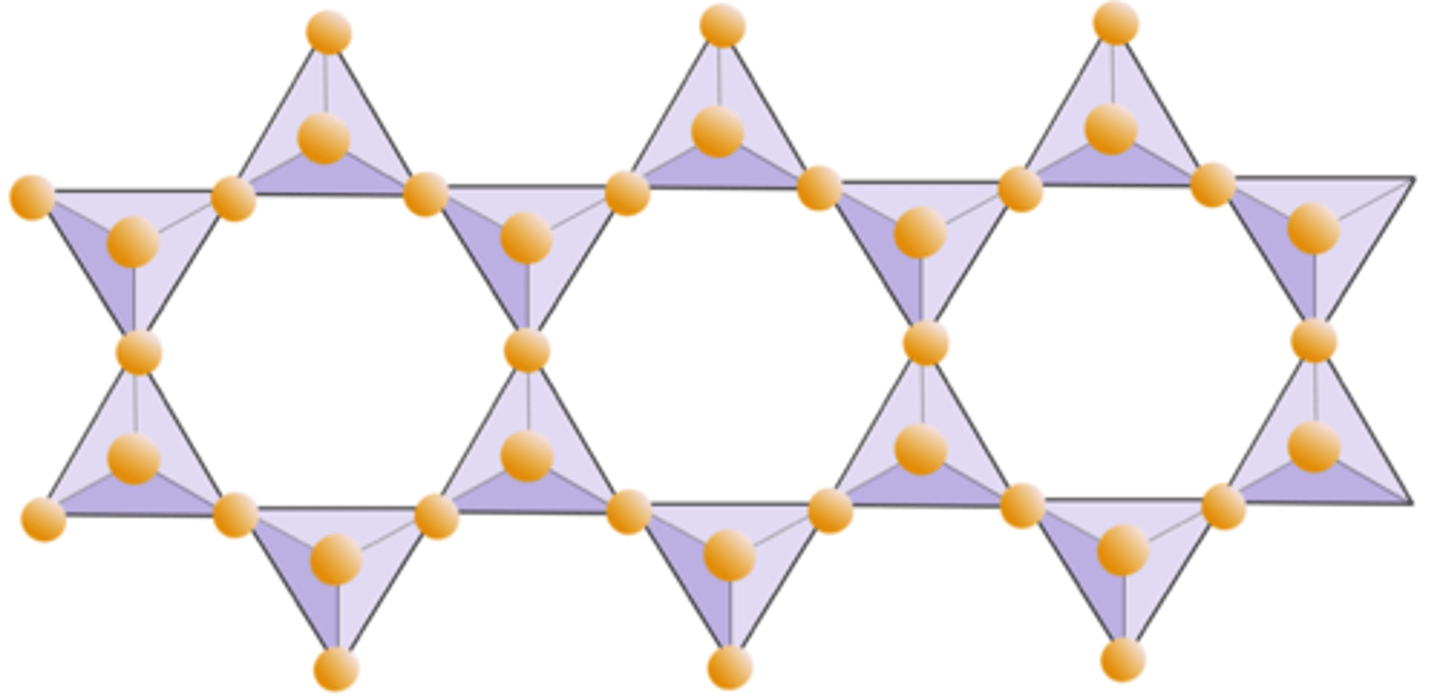
Amphibole (Fact 5)
Family of Silicate minerals (((RSi4O11)2) (where R can be any number of cations)) characterized by being a whole range of different colors (based on their chemical composition)
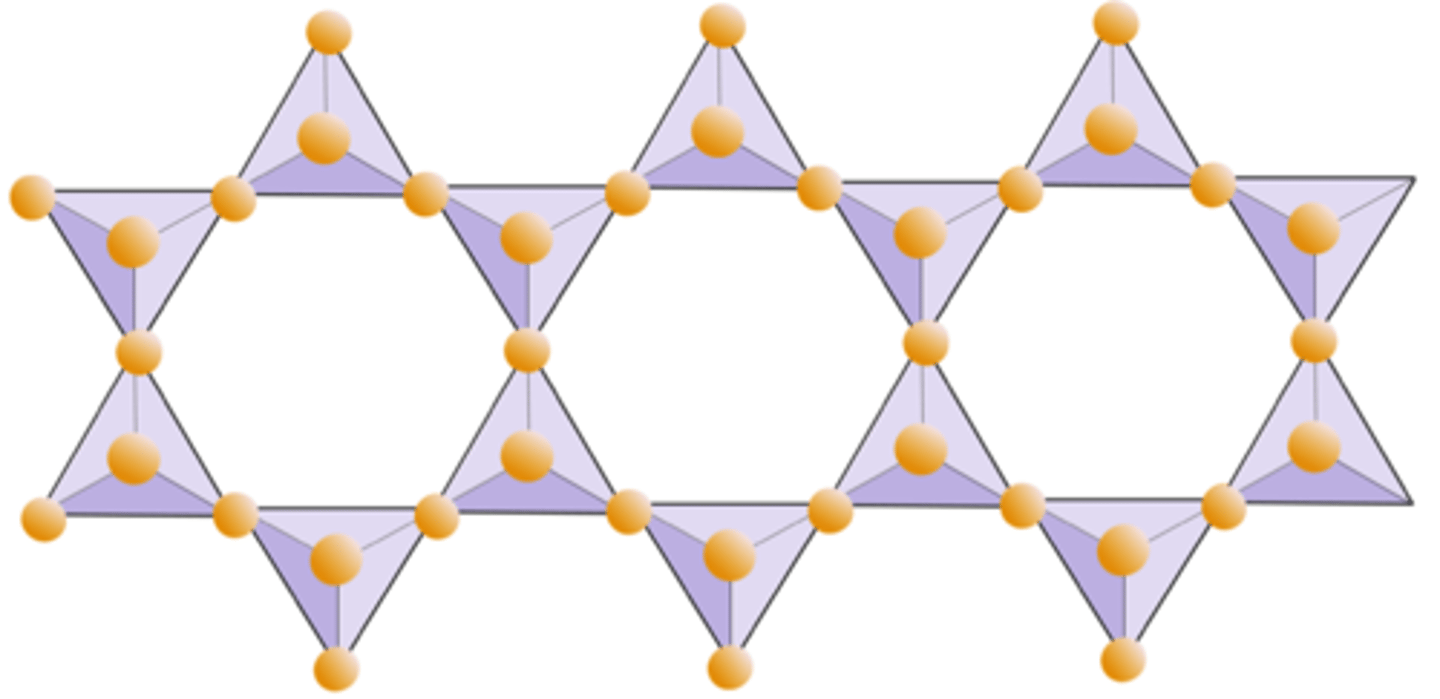
Amphibole (Fact 6)
Family of Silicate minerals (((RSi4O11)2) (where R can be any number of cations)) characterized by also having ends that are hydroxide ions (OH-), which occurs from an interaction between the growing minerals and water dissolved in magma
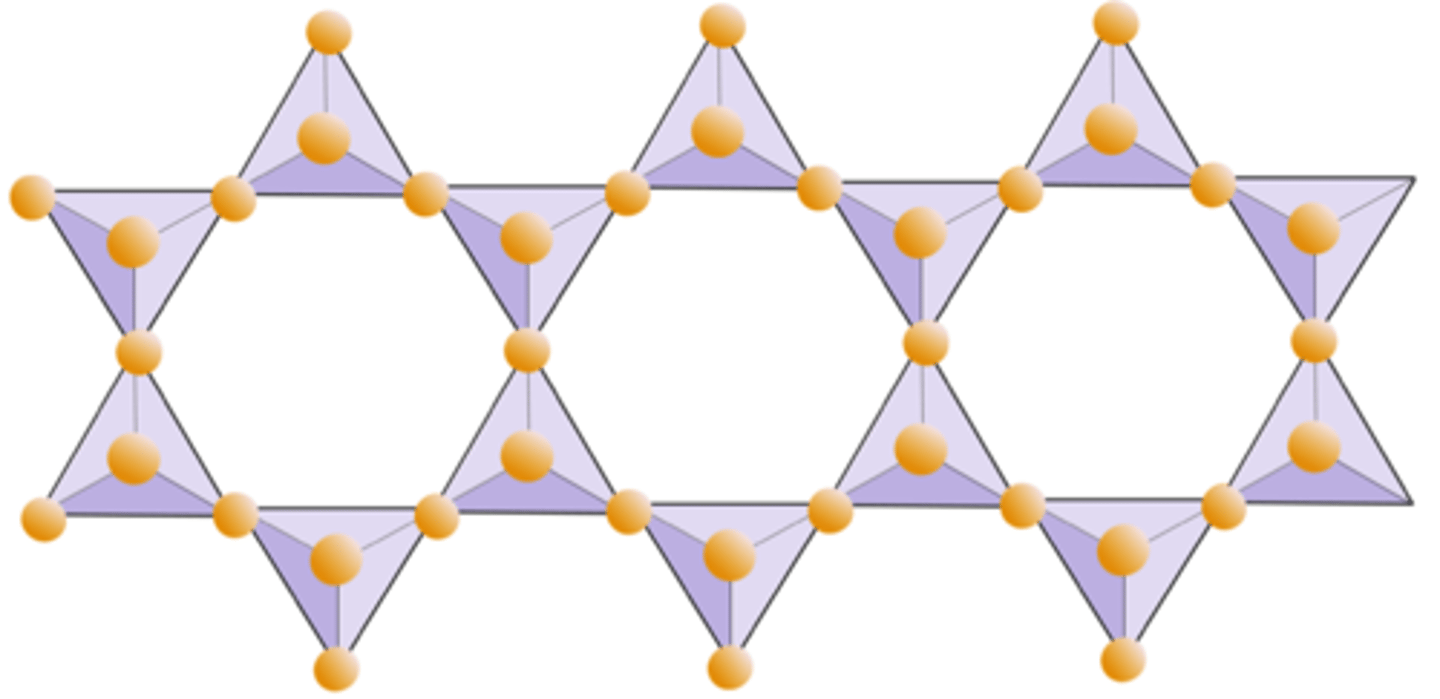
Amphibolite (Fact 1)
Metamorphic rock primarily made of Amphiboles
Andesite (Fact 1)
Intermediate and Porphyritic Extrusive Igneous Rock usually made of hornblende, biotite, and plagioclase feldspar and appears gray
Banded Iron Formations (Fact 1)
Sedimentary Rock consisting of alternating layers of Iron Oxides and Chert
Banded Iron Formations (Fact 2)
Sedimentary Rock made of Iron and Chert that (likely) formed during the Precambrian Supereon around 3.7 BYA, discovered during the 19th Century in Michigan
Banded Iron Formations (Fact 3)
Sedimentary Rock made of Iron and Chert that (likely) formed as a result of the dissolved Iron (from other sedimentary rock existing at the time of the Precambrian) within the oceans of Earth having been oxidized by the increasing amount of Oxygen produced by cyanobacteria during the Paleoproterozoic Era (which eventually led to the Great Oxidation Event) thus forming insoluble iron oxides which precipitated out, forming a thin layer on the ocean floor
Banded Iron Formations (Fact 4)
Sedimentary Rock made of Iron and Chert in which each distinctive band formed is a result of different cycles of oxygen production, that is, after their initial formation, there soon became a time again on Earth when Iron sediment would be in the ocean and would be oxidized to form the bands, except it would form a new band that would sit on top of the old, and would do this every time forming the bands one can examine today
Banded Iron Formations (Fact 5)
Sedimentary Rock made of Iron and Chert which provides around 60% of Iron for its various uses and applications
Basalt (Fact 1)
Mafic and Aphanitic and Vesicular and sometimes Porphyritic Extrusive Igneous Rock, which makes up the entire ocean floor and is formed at mid-ocean ridges
Calcite (Fact 1)
Type of Carbonate (CaCO3) that is tied for the most abundant Carbonate and is typically found in limestone
Calcite (Fact 2)
Type of Carbonate (CaCO3) that exhibit a unique property called birefringence
Carbonates (Fact 1)
Family of Non-Silicates that contain the namesake ion or CO3 2- that are formed via precipitation, evaporation, and/or marine-biological processes
Carbonates (Fact 2)
Family of Non-Silicates that are the most abundant of the families of Non-Silicates
Chert (Fact 1)
A very fine grained version of silica deposited with or without microfossils
Chert (Fact A)
Sedimentary Rock composed of micro-crystalline Quartz
Clay (Fact 1)
Type of Phyllosilicate that is made of Hydrous Aluminum Silicates
Clay (Fact 2)
Type of Phyllosilicate that is found in Sedimentary Rocks
Diorite (Fact 1)
Intermediate and Phaneritic Intrusive Igneous Rock usually made of black hornblende, black biotite, and white plagioclase feldspar
Dolomite (Fact 1)
Type of Carbonate (CaMg(CO3)2) that is tied for the most abundant Carbonate and is typically found in Dolostone rocks and formed via evaporation and precipitation
Fayalite (Fact 1)
Member of the Olivine Family that has a pure Iron-end member, in other words Olivine with no Magnesium in it
Feldspar (Fact 1)
Type of Framework Silicate (SiO2 with K, Al, Na, and/or Ca), it is the most abundant mineral in the Earth's Crust, making up around 50% of all of its minerals
Feldspar (Fact 2)
Type of Framework Silicate (SiO2 with K, Al, Na, and/or Ca) that is typically found in Igneous Rocks such as Granite, Rhyolite, and Basalt; in Metamorphic Rocks, and in Detrital Sedimentary Rocks
Felsic Minerals (Fact 1)
Classification of Silicates based on their chemical composition, typically being, in terms of amount: rich in Silica and poor in metal cations such as Magnesium and Iron
Felsic Minerals (Fact 2)
Classification of Silicates based on their chemical composition, they include Quartz, Feldspars, and Muscovite Mica
Forsterite (Fact 1)
Member of the Olivine Family that has a pure Magnesium-end member, in other words Olivine with no Iron in it
Framework Silicate (Fact 1)
Family of Silicate minerals that includes Quartz and Feldspars that have a structure of a layer of silica tetrahedra in which all four (corner) Oxygen atoms each bond to another Oxygen atom and in which the layers are connected not by a metal cation but rather by each other - there is a
Framework Silicate (Fact 2)
Family of Silicate minerals that includes Quartz and Feldspars that have the namesake kind of structure in which there are spaces for other ions like K, Ca, etc. to fill up, giving rise to the variety of the series of minerals that can form
Gabbro (Fact 1)
Mafic and Phaneritic Intrusive Igneous Rock usually made of Mafic minerals like Pyroxene and has minor amounts of plagioclase, it is a major component of the (lower) oceanic crust
Granite (Fact 1)
Felsic and Phaneritic Intrusive Igneous Rock usually made of Quartz, salmon-pink Potassium Feldspar, and white Plagioclase crystals (that have visible cleavage planes), and representative of the Earth's continental crust
Group (Fact 1)
Term that refers to the classification of minerals based on their anion, that is whether or not they contain an anion made of Silicon and Oxygen, in which there are Silicates and Non-Silicates, it is the more broad of the general classification of minerals
Gypsum (Fact 1)
Formed from the evaporation of water and is usually hydrated
Halides (Fact 1)
Family of Non-Silicates that contain the anion of Fluorine, Chlorine, Bromide, or Iodine and are formed by evaporation of seawater (or any other isolated body of water)
Halides (Fact 2)
Includes Halite (Sodium Chloride), Sylvite (Potassium Chloride), and Fluorite (Calcium Fluoride)
Halite (Fact 1)
Also known as rock salt, or table salt. 3 cleavages at 90°, cubic crystal habit. Typically clear or white, hardness of 3
Hematite (Fact 1)
Most diverse Iron Oxide polymorph which includes different forms such as Massive, Specular, Botryoidal, and Oolitic
Hydrated Oxides (Fact 1)
Form when Iron is exposed to Oxygen and Water
Iron Oxides (Fact 1)
Applications: Producing metallic iron via the smelting of the namesake ore, producing Carbon Dioxide as a byproduct
Iron Oxides (Fact 2)
Appearance: Gives a red color to the rocks they are in
Iron Oxides (Fact 3)
Includes Hematite, Ice, Bauxite, Corundum, Limonite, and Magnetite
Limestone (Fact 1)
Type of Sedimentary rock that usually is produced by sediments accumulating on the ocean floor from the detaching of the hard shells and parts of structures of dead marine animals and the vast majority of it is produced in this way despite the fact it can be produced inorganically
Limestone (Fact 2)
Type of Sedimentary Rock composed of Calcite that is formed via the lithification of fossilized marine organisms
Mafic Minerals (Fact 1)
Classification of Silicates based on their chemical composition, typically being, in terms of amount: rich in Magnesium and Iron and poor in Silica
Mafic Minerals (Fact 2)
Classification of Silicates based on their chemical composition, they are sometimes referred to as "dark-colored Ferro-Magnesians" and include Olivines and Pyroxenes
Mafic Minerals (Fact 3)
Classification of Silicates based on their chemical composition, they are characterized by being relatively more dense than any mineral other than them, which in turn controls the behavior and determines the density of the igneous rocks they form and in turn, the tectonic plates made of such igneous rocks
Mica (Fact 1)
Type of Phyllosilicate in which its structure is that of polymerized sheets of silica tetrahedra with an octahedral layer in between them and, like all Phyllosilicates, connected by a metal cation layer, specifically a Potassium cation layer that connects the sheets via Van Der Waals intermolecular forces
Mica (Fact 2)
Type of Phyllosilicate in which its structure gives it the property of having good cleavage and can be separated into its distinct sheets quite easily due to the nature of the Van Der Waals forces exerted by the Potassium cations holding the sheets of tetrahedra together
Mica (Fact 3)
Type of Phyllosilicate that is found in Igneous and Metamorphic Rocks and contains mostly Silica, Aluminum, and Potassium
Mica (Fact 4)
Type of Phyllosilicate that includes Biotite (found in Granite) and Muscovite (found in Schist)
Native Elements (Fact 1)
Family of Non-Silicates that contain NO anions and rather are just the metals (or nonmetals) found in nature themselves including most commonly (due to its inactivity) - Gold, as well as Carbon (as Diamond or Graphite), Silver, Copper, Platinum, Mercury, and Sulfur; and very rarely (due to their reactivity) - Iron, Lead, and Aluminum
Neosilicates (Fact 1)
Minerals that have isolated or independent Silicon-Oxygen Tetrahedra, also called orthosilicates
Neosilicates (Fact 2)
Minerals that include Olivine, Zircon, Garnet, Topaz, and Kyanite to name a few
Non-Silicate Series (Fact 1)
Term that refers to the classification of non-Silicate minerals based on their anion group, whether it be Carbonates, Oxides, Halides, Sulfides, Sulfates, Phosphates, or no anion group at all (naturally occurring element(s))
Non-Silicates (Fact 1)
Group of minerals characterized by NOT containing an anion made of Silicon and Oxygen in their chemical composition, such as the Silicon-Oxygen Tetrahedron, and thus containing any Silicon at all
Obsidian (Fact 1)
Extrusive Igneous Rock that forms from the cooling of lava in which the process of cooling is so quick that not even microscopic crystals grow - there are no crystals at all and therefore no minerals that makeup the rock (in some cases they do have microscopic crystals - but they are very tiny and there are very little of them)
Obsidian (Fact 2)
Consists of "volcanic glass", it is NOT a mineral, but has and is greatly representative of a physical property of minerals - conchoidal fracture
Olivine (Fact 1)
Family of Silicate minerals (Fe, Mg)2SiO4), its structure is that of isolated silicon-oxygen tetrahedra, NOT connected in any way, NOT a polymer in any way
Olivine (Fact 2)
Family of Silicate minerals (Fe, Mg)2SiO4) typically found in mafic igneous rocks and the mantle, but also easily weathered in surface conditions (which would change its characteristic green color), it is the mineral form of Peridot
Olivine (Fact 3)
Family of Silicate minerals (Fe, Mg)2SiO4) that are found in magma in which when cooled, form and thus are found in igneous rocks when the magma solidifies, the relative amounts of Iron and Magnesium in the parent magma determine which minerals in the series of the namesake family form
Olivine (Fact 4)
Family of Silicate minerals (Fe, Mg)2SiO4) characterized by being the namesake shade of green, being translucent
Orthoclase Feldspar
Family of Feldspars...
Oxides (Fact 1)
Family of Non-Silicates that contain the namesake ion or O2- and includes Rust, and its Hydrated and Iron forms
Pegmatite (Fact 1)
Pegmatitic Igneous Rock
Peridotite (Fact 1)
Intrusive ultramafic rock made of olivine and pyroxene, it is found in the mantle and makes up the majority of rocks in the mantle
Phosphates (Fact 1)
Family of Non-Silicates that contain the namesake anion PO4 3- and is sometimes combined with various other anions and sometimes Arsenic and/or Vanadium can substitute for the namesake ion due to the three ions' similar properties
Phosphates (Fact 2)
Includes Apatite (bones/teeth) and the (hydrated) Turquoise gemstone
Phyllosilicate (Fact 1)
Family of Silicate minerals ((R(Si4O10)) (where R can be any number of cations and that contains Silicon and Oxygen in a 2:5 ratio) in which its structure is that of
all three of their bottom (corner) Oxygen atoms shared between individual tetrahedra thus forming a sheet
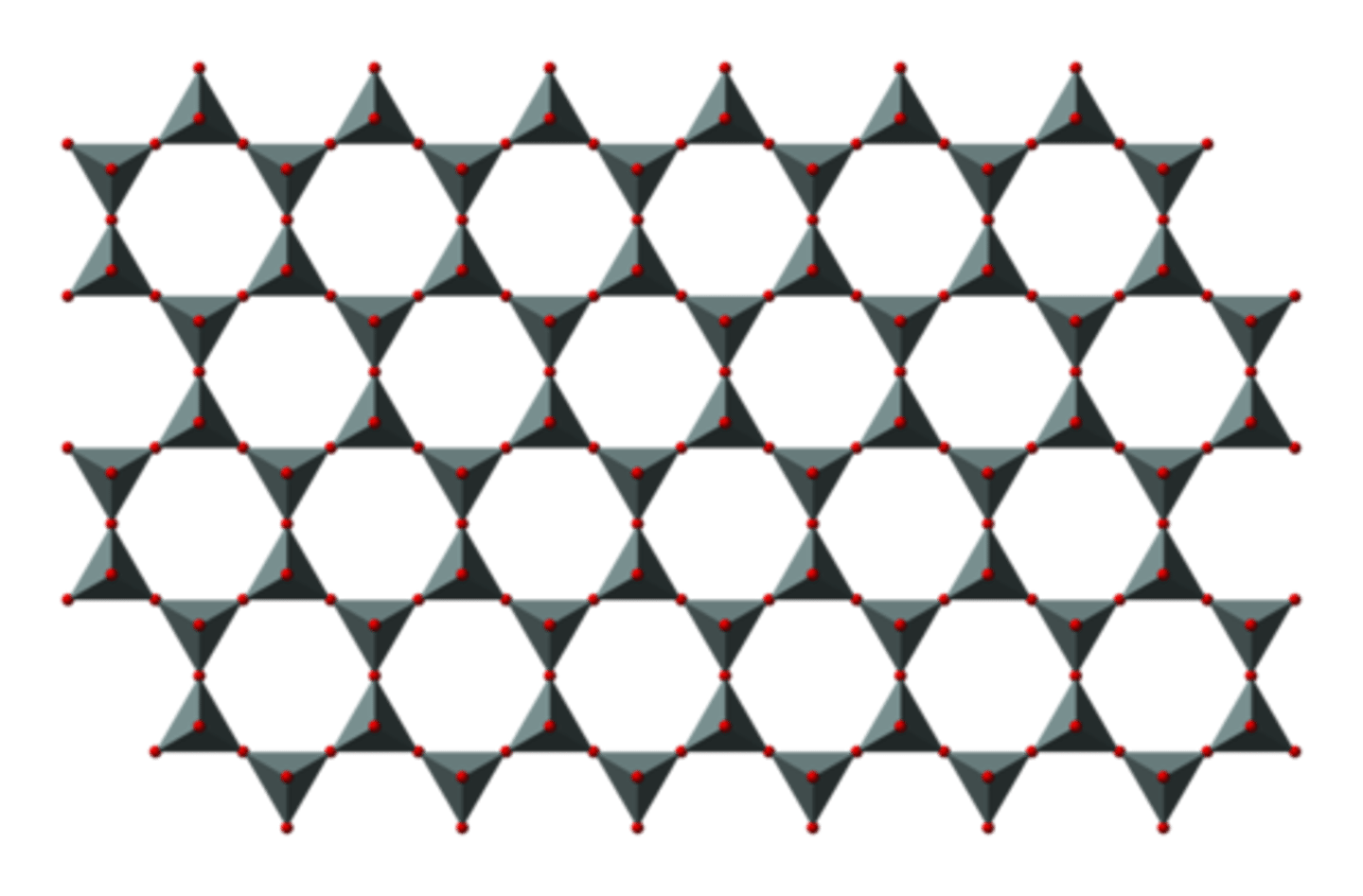
Phyllosilicate (Fact 2)
Family of Silicate minerals ((R(Si4O10)) (where R can be any number of cations and that contains Silicon and Oxygen in a 2:5 ratio) in which its structure has a top (corner) Oxygen atom available for bonding with other atoms and thus each of sheet is connected by a metal cation layer
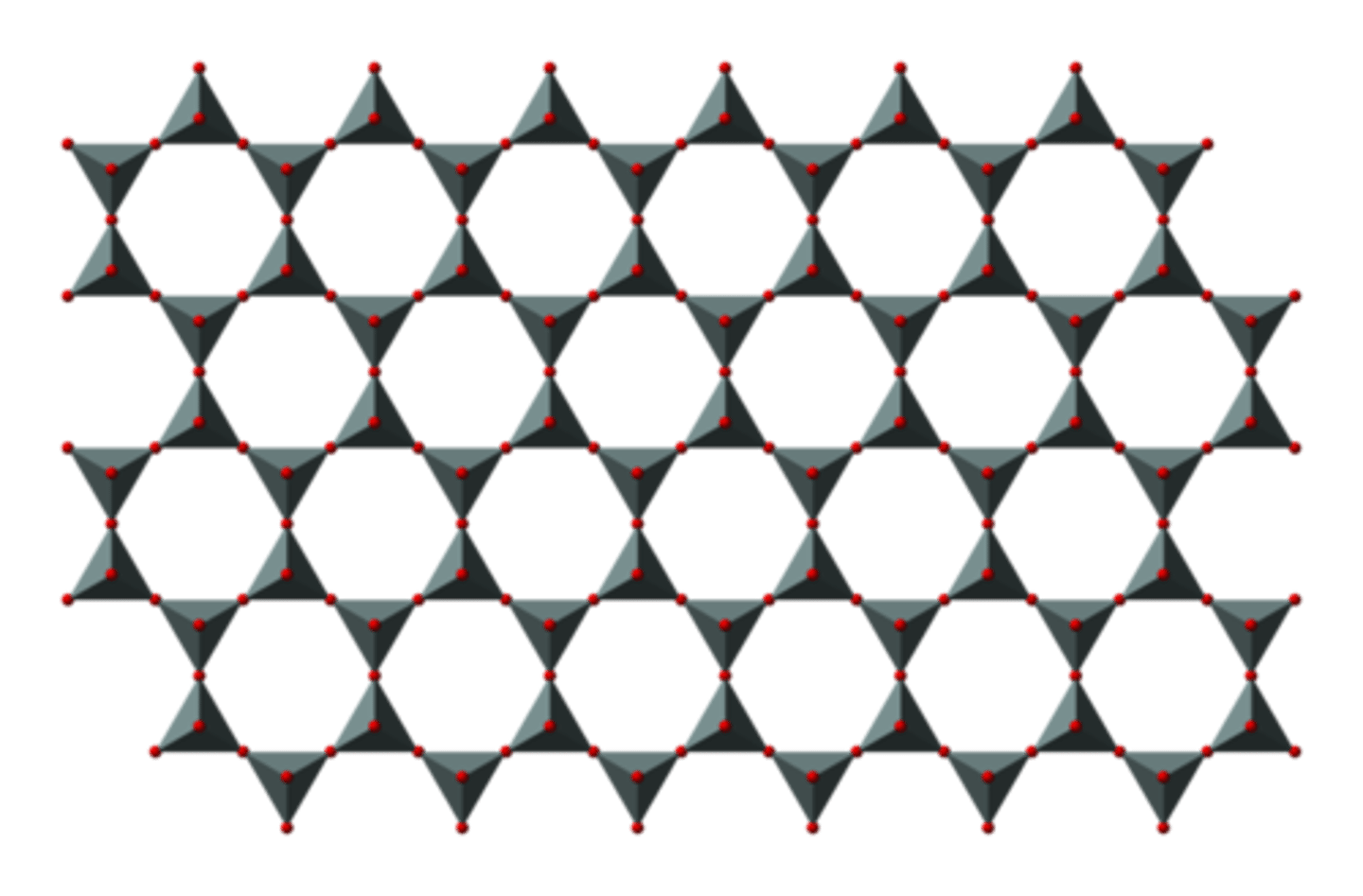
Plagioclase Feldspar
Family of Feldspars containing sodium and/or calcium in addition to aluminum, silicon, and oxygen...
Pumice (Fact 1)
Extremely vesicular Igneous Rock which is so vesicular (has so many vesicles) that its density is lower than that of water (it can float)
Pyroxene (Fact 1)
Family of Silicate minerals (XZ(Al, Si)2O6), its structure is that of a polymer chain of Silicon-Oxygen Tetrahedra in which one of the (corner) Oxygen atoms bonds with another and so on and each polymer chain is bonded to a metal cation to form the crystalline structure

Pyroxene (Fact 2)
Family of Silicate minerals (XZ(Al, Si)2O6) typically found in mafic igneous rocks including Peridotite, Basalt, and Gabbro as well as some metamorphic rocks including Eclogite and Blue Schist

Pyroxene (Fact 3)
Family of Silicate minerals (XZ(Al, Si)2O6) characterized by being dark green or black in color and blocky

Quartz (Fact 1)
Type of Framework Silicate (SiO2), it is the most abundant mineral on Earth's surface
Quartz (Fact 2)
Type of Framework Silicate (SiO2 with occasional impurities), it can have impurities, which consist of atoms within the "framework" structure of the mineral which give rise to the varieties of the namesake mineral which include gemstones such as Amethyst and Citrine
Quartz (Fact A)
Resistant to disintegration by weathering and extremely durable
Red Bed (Fact 1)
Sedimentary Rock made of Sandstone, Siltstone, and Shale that are the namesake color since Iron Oxides dominate their composition
Rhyolite (Fact 1)
Felsic and Aphanitic Extrusive Igneous Rock usually made of pink microcrystals and quartz phenocrysts
Rust (Fact 1)
Most common Oxide - combination of Iron Oxides and Hydrated Oxides
Salt (Fact 1)
Non-Silicate mineral made by replacing the Hydrogen atom in an Acid with a cation metal, include minerals such as Halite (Sodium Chloride) and Gypsum (Calcium Sulfate) formed by the replacement of Hydrogen in Acids with cation metals such as Sodium in Halite forming in place of Hydrogen in Hydrochloric Acid
Salt (Fact 2)
Non-Silicate mineral made by evaporation, sometimes called "Evaporite Minerals"
Scoria (Fact 1)
Vesicular Igneous Rock
Silicate (Fact 1)
Group of minerals characterized by containing an anion made of Silicon and Oxygen in their chemical composition, such as the Silicon-Oxygen Tetrahedron
Silicate Series (Fact 1)
Term that refers to the classification of Silicate minerals based on their cations' ionic sizes, that is which element or elements, as an ion, makeup the cationic part of the molecule, it is the more specific of the general classification of minerals
Suavjarvi Crater (Fact 1)
Oldest known impact crater on Earth
Sudbury Basin [Crater] (Fact 1)
Fourth oldest known impact crater on Earth, it is the third largest impact crater on Earth
Sulfates (Fact 1)
Family of Non-Silicates that contain the namesake anion SO4 2-
Sulfates (Fact 2)
Includes Gypsum (Hydrated Calcium Sulfate) and Anhydrite (Calcium Sulfate)
Sulfides (Fact 1)
Family of Non-Silicates that contain the anion of S2-
Sulfides (Fact 2)
Includes Galena, Sphalerite, Pyrite, Chalcopyrite
Sulfides (Fact 3)
Its ores and other similar minerals of its type are used to produce various metals including mainly Lead, Zinc, and Copper; but also Nickel, Antimony, Molybdenum, Arsenic, and Mercury
Trace Fossil (Fact 1)
Fossil or fossil record of or associated with biological activity but does not contain any of the remains of the organism with which it is associated but rather indicators that the organism was at one point living on the land from which the fossil came
Travertine (Fact 1)
Porous, concentric, or layered variety of carbonate that forms with often heated water in springs and/or caves
Tufa (Fact 1)
Porous variety of carbonate that form in relatively unheated water, sometimes as towers and spires
Tuff (Fact 1)
Pyroclastic Igneous Rock made from Tephra fragments